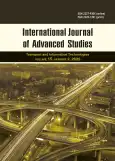Morphometric criteria for evaluating individual territorial units in solving the problem of spatial development of linear objects of terrestrial transport infrastructure
- Authors: Kuzmin D.V.1
-
Affiliations:
- Russian University of Transport (MIIT)
- Issue: Vol 15, No 2 (2025)
- Pages: 143-160
- Section: Articles
- Published: 30.06.2025
- URL: https://journal-vniispk.ru/2328-1391/article/view/299257
- DOI: https://doi.org/10.12731/2227-930X-2025-15-2-367
- EDN: https://elibrary.ru/KZWCRR
- ID: 299257
Cite item
Full Text
Abstract
Background. The article discusses the issue of evaluating the morphometric properties of a polygon in order to form a rating matrix necessary to solve the problem of finding a path in a discrete space. This approach to solving the problem of spatial development of linear objects of land transport will be useful in solving practical problems of camera tracing.
Materials and methods. The landfill in question is separated into separate territorial units, each of which has its own rating based on a set of different criteria (anthropogenic load, morphometry, etc.). The rating of a particular territorial unit determines the prospects of its consideration when solving the tracing problem. Such a discrete polygon model is actually a weighted graph, in which the search for a path is carried out by various search algorithms: A*, Dijkstra, Breadth-first search. Since the assessment of a particular territorial unit based on the morphometric properties of an area depends on its size, it is proposed to evaluate the polygon in two stages with different resolutions of discrete space, i.e. enlarging individual territorial units into blocks. As an example, in the work, the initial high-resolution height matrix was programmatically generated, which was later combined into blocks. With respect to the matrix of formed blocks, sensitivity analysis was performed according to 4 criteria: the average slope of the block, the standard deviation of heights, the height range and the roughness index.
Results. It follows from the experimental results that the "Height range" criterion has the highest average sensitivity and, as a result, weight. This means that this criterion has a greater impact on the formation of block ratings. At the same time, the graph of rating changes according to this criterion and the color matrix of the weight range allow us to conclude that this criterion is the least informative, since it weakly distinguishes the blocks from each other.
About the authors
Dmitry V. Kuzmin
Russian University of Transport (MIIT)
Author for correspondence.
Email: kuzminmiit@yandex.ru
SPIN-code: 1092-1985
Candidate of Technical Sciences, Associate Professor, Associate Professor of Logistics and Management of Transport Systems
Russian Federation, 9, build. 9, Obraztsova Str., Moscow, Russian FederationReferences
- Malczewski, J. (2000). On the use of weighted linear combination method in GIS: Common and best practice approaches. Transactions in GIS, 4(1), 5–22. https://doi.org/10.1111/1467-9671.00035
- Ahuja, R., Mehlhorn, K., Orlin, J., & Tarjan, R. (1990). Faster algorithms for the shortest path problem. Journal of the ACM, 37, 213–223. https://doi.org/10.1145/77600.77615
- Dijkstra, E. W. (1959). A note on two problems in connexion with graphs. Numerische Mathematik, 1(1), 269–271. https://doi.org/10.1007/BF01386390
- Botea, A., Müller, M., & Schaeffer, J. (2004). Near optimal hierarchical path-finding. Journal of Game Development, 1(1), 1–22.
- SP 119.13330.2017 Railways of 1520 mm gauge. Updated version of SNiP 32-01-95 (with Amendment No. 1). (2017). Retrieved July 19, 2023, from https://docs.cntd.ru/document/550965737
- Terrain classification by height - Geoinformation system. Retrieved June 5, 2025, from https://geo.god-tigra.ru/klassifikatsiya-mestnosti-po-vysote.php
- Explanatory morphometry of relief | GeoKniga geological Portal. Retrieved June 6, 2025, from https://www.geokniga.org/books/16102
- Osintsev, N. A. (2021). Multicriteria decision-making methods in "green" logistics. The World of Transport, 19(5), 105–114. https://doi.org/10.30932/1992-3252-2021-19-5-13
- Uyan, M., Cay, T., Akcakaya, O., & A Spatial Decision Support System design for land reallocation: A case study in Turkey. Computers and Electronics in Agriculture, 98, 8–16. https://doi.org/10.1016/j.compag.2013.07.010
- Feizizadeh, B., & Blaschke, T. (2013). GIS-multicriteria decision analysis for landslide susceptibility mapping: Comparing three methods for the Urmia lake basin, Iran. Natural Hazards, 65, 2105–2128. https://doi.org/10.1007/s11069-012-0463-3
- Minh, N. Q., Huong, N. T. T., Khanh, P. Q., Hien, L. P., & Bui, D. T. (2024). Impacts of resampling and downscaling digital elevation model and its morphometric factors: A comparison of Hopfield neural network, bilinear, bicubic, and kriging interpolations. Remote Sensing, 16(5), 819. https://doi.org/10.3390/rs16050819
- NumPy. Retrieved June 2, 2025, from https://numpy.org
- Matplotlib — Visualization with Python. Retrieved June 2, 2025, from https://matplotlib.org
- Podinovskiy, V. V. (2017). Sensitivity of multicriteria selection to changes in assessments of the importance of heterogeneous criteria. Itnou: Information Technologies in Science, Education and Management, (4), 23–27.
- Nelyubin, A. P. (2019). Development of methods for analyzing multi-criteria tasks using information on the importance of criteria. 138 p.
Supplementary files










